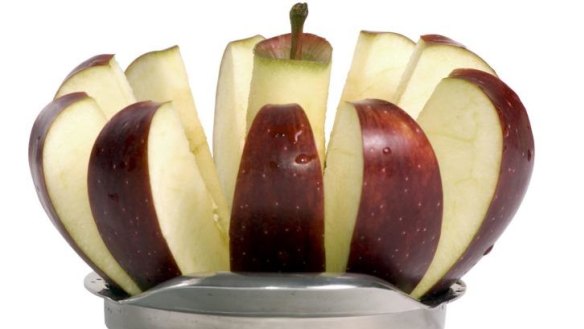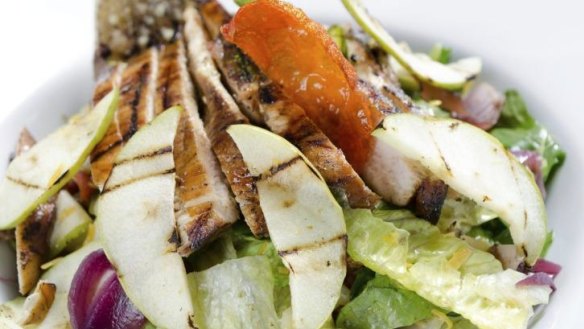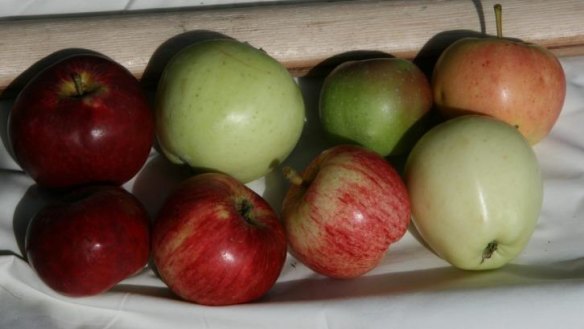Owen Pidgeon: Apple harvest under way in Canberra

The apple harvest has begun in earnest and consumers will be delighted that there will be an abundance of apples coming onto the market over the next four months. The real decision for many will be "Which apple should I choose?" In reply I will always ask: "Do you like sweet or tart apples?" and the second question would be: "Do you have any childhood favourites?"
I would put forward the view that all apples are crisp when picked fully ripe off the tree, so if you are eating an apple which is floury, it has probably been in cold storage for many months or has been sitting around in the sunshine for too long, after being picked.
Orchardists have been giving more attention to planting out a wider range of varieties over the past decade. Big commercial orchards in the big apple growing regions like Batlow, Orange, the Huon Valley and the Adelaide Hills areas are still growing a limited number of varieties, but they are replanting some out of favour varieties that they believe the general public would wish to buy.

I have adopted a much broader approach, choosing to plant out some 120 varieties, that are all shapes and sizes and mature somewhere between New Year and the end of June. There are plenty of apple varieties to choose from, with over 4000 recorded varieties around the world. From my research over the years, England, the United States of America, France and Hungary have the privilege of claiming the highest numbers of home-grown varieties.
Apples are one of the most important and widely grown fruits in the world and they can be traced back thousands of years to the Caucasus region which lies between the borders of Russia and China.
Most of the apples still grown in backyards and orchards today have their history well recorded. As we visit a selection of apple varieties, we can think that we are travelling far away and back to earlier times.

The early maturing, red blushed Gravenstein apple is a case in point. It was found growing in the grounds of the Castle Graefenstein in southern Denmark in 1669 (now part of Germany). Even then, apples growers were searching for new varieties and soon scions were sent to the orchard of northern Italy. In the early 19th century it was introduced to England, America and Canada.
The Gravenstein as it is now known, is one of the earliest maturing apples that will keep well for two-three weeks and can be used both as a fresh eating apple and in cooking. Its white flesh is wonderfully aromatic, juicy and crisp and a little on the tart side. It will produce wonderful baked apples and is one of the quality apples used in making apple sauce.
People from northern Europe come searching for this apple with its distinctive flavour. From our first harvest of three apples, we gave one to our then church pastor who had grown up in Germany. He took one to his mother in hospital and tears came to her eyes when she bit into the apple for it reminded her of her rural childhood in Germany.
One of the earliest maturing golden delicious varieties is the papierowski Polish apple, originally named after its very thin skin 'the paper apple'. The white flesh is very flavoursome, slightly sharp and tangy. Whenever any member of the Australian Polish community tastes this apple, they are reminded of their homeland.
The same story can be told about apples in the childhood memories of Australian-born folk. Abas is an early maturing red stripy apple that originated in Mock's Orchards in Victoria in 1940. This sweet apple was grown extensively in the southern regions.
As well, Victoria was the main entry point for the March maturing snowy apple. Its full title is Pomme de Neige (apple of the snow) and it has travelled the world to come to Australia. It can be traced back to France, circa 1730 then it was taken across the Atlantic and planted in Vermont State. It soon became a favourite of the French Canadians in Quebec. Its flesh is brilliantly white and the red skin has pink undertones when you bite into this apple.
Of course, you might wonder how the title "royal" came to be in the name of one of New Zealand's most famous apples. The royal gala was propagated in 1934 in Greytown, being a cross between Kidd's orange red and the golden delicious. As the years went by, its qualities were well recognised, and when Queen Elizabeth toured New Zealand she was given a presentation box of this variety. She was so impressed and requested more. The Queen of the Netherlands also gave her glowing endorsement to this new apple in 1971 and so the name came to be.
For our English friends, there are many apples of renown, with many maturing in the mid-season months of March and April (in the southern hemisphere). The most sought after English eating apple is the Cox's range ippin which was propagated by a Richard Cox in Buckinghamshire, in 1825. It is deliciously sweet with a spicy, honeyed flavour. Growing this in Australia is a real challenge as it does not take too kindly to our hot summer days, however we do have some fine specimens growing this season. This apple is one of the parents of Kidd's orange red so the royal gala does have a fine lineage.
Two other fine English origin eating apples which we also grow are the Blenheim orange pippin and the Lord Lambourne. The Blenheim orange, dates back to 1740 and was a tree found growing against the boundary wall of Blenheim Park, nearby to the famous Blenheim Palace, which was later the birthplace of Sir Winston Churchill. For the connoisseurs of cooking apples, we are growing the Bramley Seedling from Nottinghamshire along with 12 other 'cookers' including the Belle de Boskoop from the Netherlands.
More recent arrivals to Australia include the fine spritely tasting topaz and svatava from the Czech Republic. There is also a very wide-ranging family of golden delicious apples that have been brought through quarantine and into production. By maturity order, they include the ginger gold, smoothee, new gold, firmgold, golden glory and goldrush.
Many tastes and many memories. Enjoy an extended season of tree ripened and freshly harvested apples this year.
Don't miss our open day
Loriendale Orchard, situated just north of Canberra, is hosting its 25th Anniversary Apple Day on Saturday, March 28. It is a charity fundraising event. On that day there will be close to 30 mid-season apples and 12 varieties of pears available. Local musicians and choirs will provide fine music for an afternoon in the country.
Grilled chicken and eggplant, with apple salad
4 free range chicken breast fillets
1 large eggplant, sliced
½ cup virgin olive oil
Salad:
2 apples
2 red onions
½ cup chopped walnuts
10 cherry tomatoes, halved
8 slices beetroot, shredded
2 mandarins, segmented
150g snowpeas
Dressing:
1 cup olive oil
4 tbs balsamic vinegar
salt and pepper
Brush the chicken breasts and eggplant slices with olive oil and place under a medium heat grill. Cook for approximately 15 minutes, basting with oil every five minutes and turning halfway through the cooking. Remove when golden brown and slice the chicken into thick strips.
Place the dressing ingredients into a capped bottle and shake well. Core and dice the apples and slice the red onions. Combine with the other salad ingredients and toss lightly with the salad dressing.
Arrange the salad on serving plates and top with chicken pieces and slices of eggplant.
This week in the garden
* Plant out silverbeet, spinach, beetroot and a row of loose leaf lettuces.
* Aim to complete the planting out of seedlings of broccoli, cauliflower and brussels sprouts to get them well established before the colder nights arrive.
* A bountiful crop of carrots, radishes or lettuces, allows you to select the most advanced for the kitchen, so providing more space to the remaining plants and spreading the harvest.
* Keep leafy greens and kale growing quickly with regular deep waterings and fortnightly applications of seaweed extract or fish emulsion foliar sprays.
* Harvest potatoes with a garden fork or pointy nosed digger when the plants have died back. Dry them off well in a shady warm space before storing them for later use.
* Seedlings of celery and leeks should now be hilled up around their base, to shield them from the hot, late summer sun.
Owen Pidgeon runs the Loriendale Organic Orchard near Hall.
Restaurant reviews, news and the hottest openings served to your inbox.
Sign up